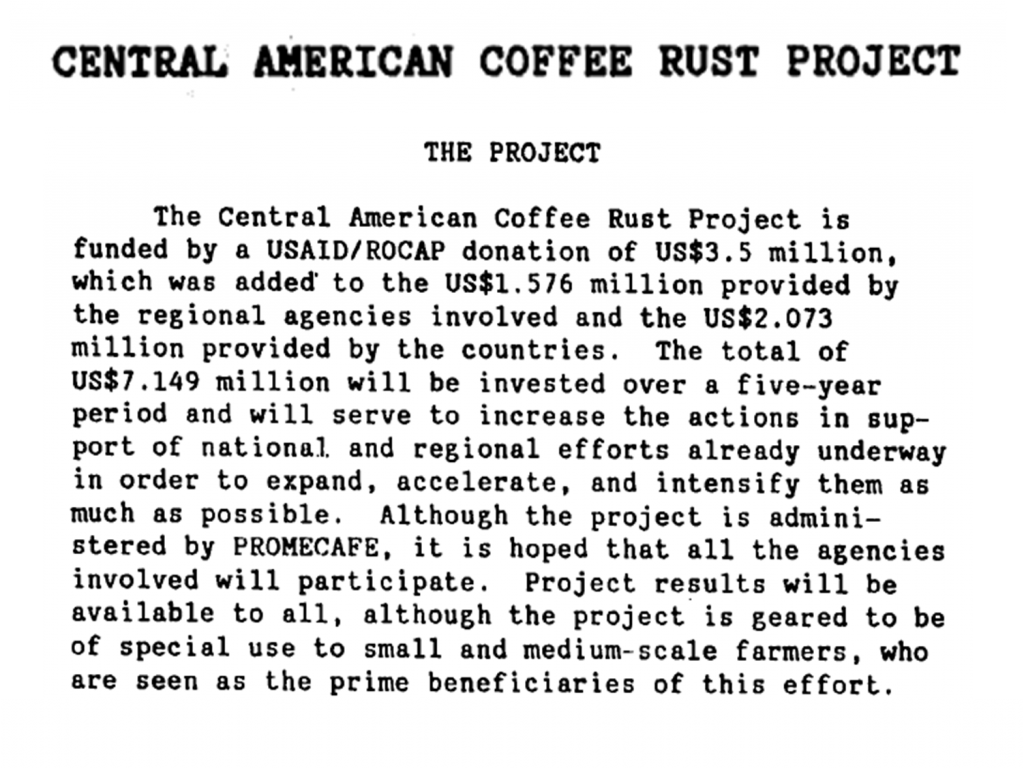by Michael Sheridan
Michael Sheridan has worked on coffee for Catholic Relief Services since 2004. He currently directs the Borderlands Coffee Project in Colombia and Ecuador and advises other CRS coffee projects in Latin America and the Caribbean. He is based in Quito and publishes perspectives from the intersection of coffee and international development for the CRS Coffeelands Blog.
Last week, agricultural authorities and coffee organizations from Central America holed up in Panama for two days with research institutes, regional banks and UN agencies to try to hammer out a plan for responding to the coffee leaf rust outbreak. As I trolled the web for news of the meeting’s results, I came across this description of a bold, five-year plan to help smallholder farmers address coffee rust:
Only, this was not written last week. It was published in 1984, four years into the region’s first coordinated response to coffee leaf rust disease. As I dove deeper and deeper into hundreds of pages of research and funding requests to address coffee rust in Central America during the 1980s, I couldn’t escape a sense of what Yogi Berra called “deja vu all over again.”
Central America has been here before. Can it respond this time in a way that will keep future generations from having to make massive investments to respond to the next coffee rust emergency?
COFFEE RUST COMES TO CENTRAL AMERICA.
Many Central American farmers were dealing with coffee rust for the first time this harvest, since it started affecting coffee at higher elevations than normal. While coffee rust may have been new to these farmers, it is hardly new to Central America. It first arrived in Carazo, Nicaragua, in 1976. The region started coordinating a response shortly after.

First Appearances of Coffee Leaf Rust in Central America. From “Coffee Rust in the Americas,” 1984.
PROMECAFÉ and THE FIGHT AGAINST COFFEE LEAF RUST DURING THE 1980s.
PROMECAFÉ is a network of coffee institutes in Central American and the Caribbean and allied research centers, including:
- Anacafé, the Asociación Nacional de Café of Guatemala;
- CATIE, the Tropical Agriculture Research and Higher Education Center in Costa Rica,
- CIB, The Coffee Industry Board of Jamaica
- CIRAD, Agricultural Research for Development, the French institute responsible for coffee and cacao research;
- CODOCAFE, the Consejo Dominicano del Café;
- ICAFE, the Instituto del Café de Costa Rica, not to be confused with
- IHCAFE, the Instituto Hondureño de Café;
- MIDA, the Ministry of Agriculture of Panamá;
- PROCAFE of El Salvador
PROMECAFÉ was established in 1979 by the Inter-American Institute for Cooperation on Agriculture (IICA) to modernize coffee farming in Mesoamerica. Among its earliest activities was coordinating a response to coffee leaf rust.
PROMECAFÉ worked through its member organizations to control coffee leaf rust in Central America throughout the 1980s, beginning with the Proyecto Regional Sobre Roya del Cafeto, whose objectives included: breeding to develop rust-resistant varieties, propagation of resistant varieties, research into the biology of the coffee rust fungus, and appropriate technical assistance to farmers to ensure the adoption of new technologies. PROMECAFÉ convened annual conferences on coffee rust control in 1984, 1985 and again in 1986; the proceedings from those events and other research published by IICA and PROMECAFÉ collaborators during the time are extraordinary in their rigor and insight.
THE 2013 PLAN.
More than 30 years later, PROMECAFÉ is back at it, taking the lead in formulating the region’s response to the current coffee rust epidemic.
The Central American Agriculture and Livestock Council announced here last week that the plan that PROMECAFÉ presented was approved. While details were scarce, the official release identified some familiar areas of focus — training in more effective management of coffee rust and expanded access to rust-resistant varieties, for example — as well as some new ones, including support for vulnerable populations and efforts to build institutional capacity for fighting coffee rust.
PREPARING FOR THE NEXT EMERGENCY.
The success of the current Central America plan in building institutional capacity for fighting coffee rust will go a long way in determining whether the region will be undertaking extraordinary measures again 30 years from now to address another wave of rust. Ideally, the region’s governments will go beyond the issue of coffee rust, helping their respective coffee institutes secure the funds and build the capacity to identify and respond to new and unforeseen challenges to coffee production in the era of climate change.
Michael Sheridan
Michael Sheridan is the Chief Executive Officer of the Coffee Quality Institute, a nonprofit organization with a mission to improve coffee quality and the lives of those who produce it. Sheridan has been leveraging market forces to make coffee work for smallholder farmers and farm workers since 2004. Most recently he directed progressive green coffee sourcing activities and direct-trade partnerships at Intelligentsia Coffee. Prior to that he worked to deliver initiatives in the coffee sector in Central and South America on behalf of Catholic Relief Services.
Comment
2 Comments
Comments are closed.







nice write up please visit my school site here http://www.unn.edu.ng
nice research.am a student of UNN and i will love it if you can visit my school site here http://www.unn.edu.ng